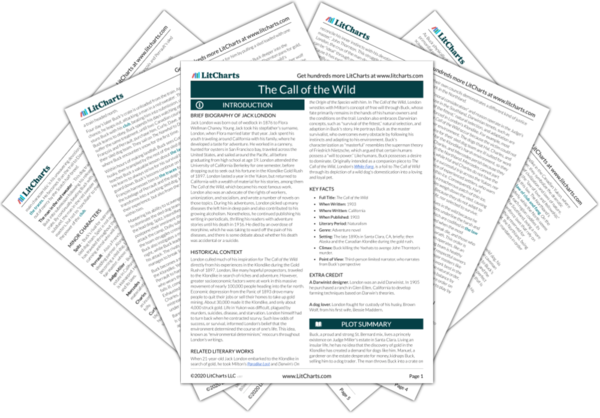Welcome to the LitCharts study guide on Jack London's The Call of the Wild. Created by the original team behind SparkNotes, LitCharts are the world's best literature guides.
The Call of the Wild: Introduction
A concise biography of Jack London plus historical and literary context for The Call of the Wild.
The Call of the Wild: Plot Summary
A quick-reference summary: The Call of the Wild on a single page.
The Call of the Wild: Detailed Summary & Analysis
In-depth summary and analysis of every chapter of The Call of the Wild. Visual theme-tracking, too.
The Call of the Wild: Themes
Explanations, analysis, and visualizations of The Call of the Wild's themes.
The Call of the Wild: Quotes
The Call of the Wild's important quotes, sortable by theme, character, or chapter.
The Call of the Wild: Characters
Description, analysis, and timelines for The Call of the Wild's characters.
The Call of the Wild: Symbols
Explanations of The Call of the Wild's symbols, and tracking of where they appear.
The Call of the Wild: Literary Devices
The Call of the Wild's key literary devices explained and sortable by chapter.
The Call of the Wild: Theme Wheel
An interactive data visualization of The Call of the Wild's plot and themes.
Brief Biography of Jack London
Jack London was born out of wedlock in 1876 to Flora Wellman Chaney. Young Jack took his stepfather's surname, London, when Flora married later that year. Jack spent his youth traveling around California with his family, where he developed a taste for adventure. He worked in a cannery, hunted for oysters in San Francisco bay, traveled across the United States, and sailed around the Pacific, all before graduating from high school at age 19. London attended the University of California Berkeley for one semester, before dropping out to seek out his fortune in the Klondike Gold Rush of 1897. London lasted a year in the Yukon, but returned to California with a wealth of material for his stories, among them The Call of the Wild, which became his most famous work. London also was an advocate of the rights of workers, unionization, and socialism, and wrote a number of novels on those topics. During his adventures, London picked up many diseases the left him in deep pain and also contributed to his growing alcoholism. Nonetheless, he continued publishing his writing in periodicals, thrilling his readers with adventure stories until his death in 1916. He died by an overdose of morphine, which he was taking to ward off the pain of his diseases, and there is some debate about whether his death was accidental or a suicide.
Get the entire The Call of the Wild LitChart as a printable PDF.

Historical Context of The Call of the Wild
London culled much of his inspiration for The Call of the Wild directly from his experiences in the Klondike during the Gold Rush of 1897. London, like many hopeful prospectors, traveled to the Klondike in search of riches and adventure. However, greater socioeconomic factors were at work in this massive movement of nearly 100,000 people heading into the far north. Economic depression from the Panic of 1893 drove many people to quit their jobs or sell their homes to take up gold mining. About 30,000 made it the Klondike, and only about 4,000 struck gold. Life in Yukon was difficult, plagued by murders, suicides, disease, and starvation. London himself had to turn back when he contracted scurvy. Such low odds of success, or survival, informed London's belief that the environment determined the course of one's life. This idea, known as "environmental determinism,” reoccurs throughout London's writings.
Other Books Related to The Call of the Wild
When 21-year-old Jack London embarked to the Klondike in search of gold, he took Milton's Paradise Lost and Darwin's On the Origin of the Species with him. In The Call of the Wild, London wrestles with Milton's concept of free will through Buck, whose fate primarily remains in the hands of his human owners and the conditions on the trail. London also embraces Darwinian concepts, such as "survival of the fittest,” natural selection, and adaption in Buck's story. He portrays Buck as the master survivalist, who overcomes every obstacle by following his instincts and adapting to his environment. Buck's characterization as "masterful” resembles the superman theory of Friedrich Nietzsche, which argued that certain humans possess a "will to power.” Like humans, Buck possesses a desire to dominate. Originally intended as a companion piece to The Call of the Wild, London's White Fang, is a foil to The Call of Wild through its depiction of a wild dog's domestication into a loving and loyal pet.
Key Facts about The Call of the Wild
- Full Title: The Call of the Wild
- When Written: 1903
- Where Written: California
- When Published: 1903
- Literary Period: Naturalism
- Genre: Adventure novel
- Setting: The late 1890s in Santa Clara, CA, briefly; then Alaska and the Canadian Klondike during the gold rush.
- Climax: Buck killing the Yeehats to avenge John Thornton's murder.
- Point of View: Third-person limited narrator, who narrates from Buck's perspective
Extra Credit for The Call of the Wild
A Darwinist designer. London was an avid Darwinist. In 1905 he purchased a ranch in Glen Ellen, California to develop farming techniques based on Darwin's theories.
A dog lover. London fought for custody of his husky, Brown Wolf, from his first wife, Bessie Maddern.












